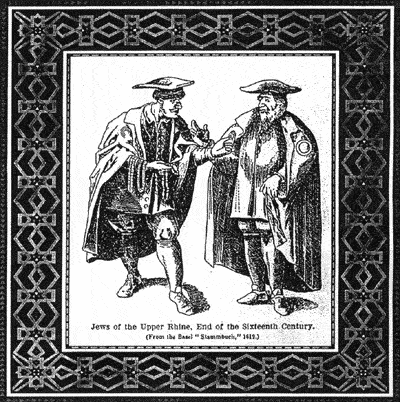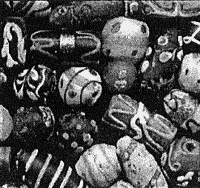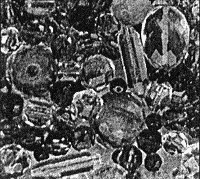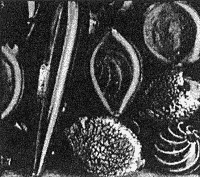Ornament and the Jews Part I - Beads
Fact Paper 20-I
Text and Images © Lois Rose Rose, all rights reserved

- Glass beads carry the essence of glass history.
- Jews have played an important role in that history.
- Since the beginning of glass manufacture by the progenitors of the Jews, these small pierced ornaments have been made using the same technology and the same decorative techniques as were used to created glass vessels. Glass beads are often found in sites such as Mesopotamian Nuzi, dated 15th century BCE, where other examples of early glassworking appear.
- Beads are man’s first ornament. Fond in every society for at least 30,000 years, beads have been used as personal adornment, interior decoration, prayer counters, currency and amulets. Even though beads are often the most durable, intact remains of a civilization, it is only in recent years that bead study has emerged as a serious scholarly subject. Given the lack of attention that has historically been paid to beads, and the age-old pattern of destruction, alteration or obfuscation of Jewish records, it follows that it is only now being recognized that Jews have been significantly involved with beads. In the case of glass beads, it is reasonable to assume that the same people who had the unique technology and skills to manufacture primary glass and glass vessels were also making the glass beads.
As Samuel Kurinsky, in The Glassmakers, has demonstrated, those people were ancestors of Abraham and eventually the children of Israel.




- Besides glass, beads are made of everything from nutshells to plastic, and there has been Jewish involvement in the creation and trade of beads of materials such as metals, gemstones, coral and pearls.
- A
gold plaque from the Byzantine Empire in the ninth century CE bears this
Greek inscription:
"According to the vow of Jacob, leader of the Synagogue, pearl merchant."
- Among the holdings of the Vatican is a classic drawing from a 16th century Hebrew manuscript of Biblical commentaries. It depicts two bearded men operating a large, fanciful contraption and the Hebrew caption identifies these Jewish men as:
"The craftsmen who manufacture pearls."

- The word "pearl"
is itself a clue to the ongoing connection Jews have had with beads. In
many languages the word for "bead" is "pearl," or
"perle," or "perlen." In The Living Torah by
Rabbi Aryeh Kaplan there is this translation of Genesis 2:12:
"The gold of that land is especially good. Also found are pearls and precious stones."
Rabbi Kaplan has translated the biblical Hebrew word bedolach as "pearls." The modern word "bead" is a product of a progression from early German. German, Dutch and Anglo-Saxon words containing the concept of "prayer," words such as bede, gebed, bitte, bida, likewise have a common derivative. As dictionary definitions are worded, it is inferred that these words for prayer came first and the words for prayer counters followed. It is logical that the Hebrew word bedolach found its way into European languages for "prayer pearls" or "beads." This theory becomes more compelling when it is remembered that the field of bead study is relatively new, and that the accomplishments of the Jews in that area have gone largely unrecognized. Given this historical hiatus it is not be surprising that etymologists failed to recognize that the modern word "beads" can be traced back to the same sounding biblical Hebrew word bedolach found in the Torah description of the Garden of Eden. Note that the Hebrew ending "lach" designates the plural as does the English "s."

- Most beads are unsigned, therefore the artisans who made them are difficult to identify. Adding to the mystery surrounding beadmakers is the secrecy Jews, and those who eventually gained their secrets, imposed upon their craft. Aside from the wisdom of protecting their proprietary know0how, the mystique of glass and glass bead manufacture enhanced the value of the product. In the Bible, for example, glass is compared in value to rubies, and clients like the Conquistadors could trade European-made glass beads for gold with the Inca people of the New World by telling the Incas that the glass beads were pieces of the stars.
- In spite of the self-imposed secrecy and the destruction of records, we find clear evidence of the Jewish connection to beads in documents such as archaeological reports, old costume prints, and historical society notes.
- For example, 50,000 glass beads were found in an excavation in Amsterdam at a site dated 16th century and identified as the old Jewish Quarter.
- 18th and 19th century folios of folk costume plates generally depict a person in a costume typical of his time, country and class in a pose denoting a typical occupation. Illustrations of Jewish costume, from biblical times through the 16th century, depict Jewish men as being well dressed, in European or Middle Eastern garb, and to denote their occupation they are shown holding strings of beads.

- Personal histories by glass researchers and bead dealers who were familiar with the bead trade in Central and Eastern Europe circa World War II tell of a strong presence of Jews in that industry, a presence that goes back to Jewish glass manufacturers in medieval Bohemia, France and Germany, supplemented at various times of trauma by refugee beadmakers.
- The Rhode Island Jewish Historical Society publication Jews in the Jewelry Industry, based on interviews conducted in 1988 and 1989, gives specific case histories of first and second generation Jews in the United States who created a vigorous jewelry industry, an industry that still includes the manufacture of glass and metal beads and of imitation pearls.
- So completely have Jews been identified with glass imitations of precious materials that faux "paste" gemstones used as set jewels or beads have commonly been called "Jewish glass." This seems appropriate, since it is supposed that one of the first uses of manufactured glass was to imitate lapis lazuli... to create the substance the Akkadian progenitors of the Jews called "lapis-from-the-kiln" to supplement royal stores of the much desired "lapis-from-the-mountain."
- Lead crystal, a much favored bead material, developed by Jewish glassmakers, has also rightly been called "Jewish glass," and the art of cutting it using lapidary techniques is historically a Jewish specialty that extends to the cutting of diamonds and other precious stones.
- Today, more people than ever before are learning the glassmaking and beadmaking arts. For those who have a Jewish heritage, the joy of creating will be enhanced by the understanding that they are carrying forth a tradition begun four thousand years before.
Concerning the Author
Lois Rose Rose is a designer/artisan for museum stores, working with fine collectible beads (see illustration from her Chai Collection). At the University of California at Los Angeles, she created and taught classes about the history and design of ornament. Lois Rose Rose is a past president of the Bead Society, Los Angeles, and a member of the Bead Museum, The society of Bead Researchers and a lecturer with the speaker’s group of the Hebrew History Federation Ltd.
References and Acknowledgements
- Braun and Schneider Costume Plates, Germany circa 1850.
- Budwig and Coles, The Book of Beads, Simon and Schuster, NY 1996, 17.
- Casady, The Bead Society Newsletter, Los Angeles, 1997.
- Castello and Capon, The Jews and Europe, Henry Holt and Co., 1994, 21,
- Dubin, Lois Sher, The History of Beads, Harry N. Abrams, NY 1987.
- Hebrew History Newsletter #77, N Y, 1998.
- Jewish Encyclopedia, Funk and Wagnalls, NY 1903, "Alchemy’," "Costume," "Crafts."
- Kaplan, Rabbi Aryeh, The Living Torch, Maznaim, NY/Jerusalem, 1981, 9.
- Kark;ins, Karlis, "Early Amsterdam Trade Beads," Ornament Magazine, 1985.
- Kurinsky, Samuel, The Glassmakers, Hippocrene NY 1991, 18,19.
- Rhode Island Jewish Historical Notes, Pawtucket, R.I.
- Rose, Lois Rose, Gifted Hands, Jewish Artisans, Ornament and Beads, Los Angeles 1997.
- Shipley, Joseph T., Dictionary of Word Origins, Dorset Press NY 1965.
- Starr, Richard F.S., Ph. D., Nuzi, Vol I, Harvard University Press, 1939, 92.
- Traub, James, "Mysterious Pearls," Smithsonian Magazine, July, 1997.
- Webster’s Seventh New Collegiate Dictionary, 1970 ed.
- Webster’s Encyclopedic Unabridged Dictionary, 1996.
- Wischnitzer, Mark, A History of Jewish Crafts and Guilds, Jonathan David, NY 1965.
